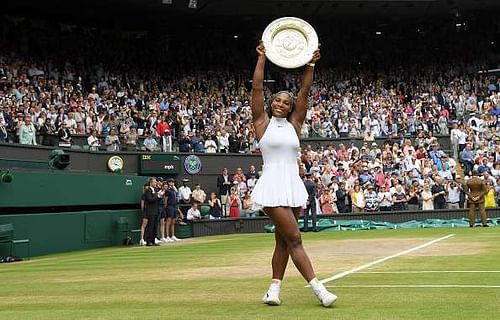
Serena Williams: Greatest of All Time
Yesterday, Serena Williams beat Angelique Kerber to win Wimbledon 2016. And she made history, in many ways. With that title, she went to a total of 22 Grand Slams, the highest of anyone in the Open Era barring Steffi Graf, whose record she equalled yesterday.
Yesterday, crowds waited with bated breath as they cheered on the defending champion, whose first set did not look as comfortable as is characteristic of the American. Nevertheless, it was Serena who broke service despite Kerber’s lofty stretches and low squats. And then, crowds waited for her to sustain that form. She did, and how.
One of the oldest players in the draw at 34 – the same age as Roger Federer, who is the oldest among the men, Serena has seen her share of trials, and then some several others have not. Injuries, illness, a decline in form, and then she came back to the blazing form she had once been in, the form fans saw at the start of the decade. Somehow, with age, the power did not diminish – it multiplied in absolute terms, decimating each opponent that stood in her path.
Most importantly, or perhaps integral to that growth in power was a growth in her mental strength. The once easily aggravated Williams is now a calmer, more collected, more gracious version of herself. Not the Serena Williams who lambasted a chair umpire in 2009, but a smiling Williams who greeted opponents and partners with the same warmth.
But en route, Serena Williams has had to face far more than most players have ever known. Straight Outta Compton isn’t just a phrase for Serena and Venus – it was reality. The youngest of her mother’s five daughters, Serena had three half-sisters – and still plays with Venus, her only ‘full’ sibling – and another legend of the tennis court. The Michigan-born sisters moved with their mother to Compton, California - a city with a violent reputation that preceded it. Known for widespread gang violence, the city has seen drug epidemics, serious civil unrest and racial attacks.
It was Compton where the sad truth of police violence against the African-American community first emerged, with the beating of taxi driver Rodney King emerging when both sisters were in their teens.
Race would be a big factor for the Williams sisters growing up and training. Despite the fact that Serena had a 46-3 win-loss record and was the top-ranked junior at the time, her father had her withdrawn from formal training after hearing his daughters subject to racial abuse.
Unfortunately, despite times having progressed, attitudes may not necessarily have done quite the same thing. The sisters were subject to racial abuse during their careers too – including a number of incidents that many fans will remember.
Case in point – Indian Wells, 2001. The stage was set for a Venus Williams vs. Serena Williams match. Only hours before the pair were due to play, Venus withdrew with an injured knee.
Father and daughter, Richard and Venus Williams entered the stadium to watch and support Serena – but instead saw loud, profane racist abuse hurled at them.
The same ‘fans’ would also go on to jeer at eventual champion Serena.
Over the years, as her titles grew, so did the jibes against the talented player. This time, they were targeted at her appearance. The strong Williams has repeatedly been the subject of attacks on her body image, describing her as ‘masculine’ – and among those attacks, several have had seriously racial undertones.
It is not just that Williams has achieved her significant laurels coming from difficult beginnings. It is that she has not just sustained her levels but magnified them. Attacked for her appearance, her gameplay, her personality, the 34-year-old has kept her head entirely in the game all through, and revelled in herself.
Young girls and women everywhere have needed a role model to look up to in a time where the media repeatedly pushes near impossible ideals of body and self-image to them. A role model who makes them realise they can, and should be proud of themselves, but also one who shows just how valuable hard work is, and how much self-belief can do.
But it was not just players and spectators who lambasted Williams. Mainstream media – here, a report in the New York Times said ...”Williams “has large biceps and a mold-breaking muscular frame, which packs the power and athleticism that have dominated women’s tennis for years. Her rivals could try to emulate her physique, but most of them choose not to.”
Tomasz Wiktorowski, the coach of Agnieszka Radwanska, who is listed at 5 feet 8 and 123 pounds, says, “It’s our decision to keep her as the smallest player in the top 10. Because, first of all she’s a woman, and she wants to be a woman.”
Repugnant racially-motivated remarks on social media have used base remarks to describe her as both male and simian, but Williams, both on social media and in life, has kept her head firmly above them.
34 years, 22 singles Grand Slams, 14 doubles Grand Slams, two Mixed Doubles Grand Slams, 28 years of hard work and an unshakeable confidence.
Last year, she became the oldest woman in the Open Era to win a major with her Wimbledon victory. This year, she raised her own bar higher. Of her 22 Grand Slam singles wins, nine have come in her 30s. In contrast, Martina Navratilova and Margaret Court, two other legends of the game, won three apiece.
Serena Jameka Williams, record breaker and maker.
